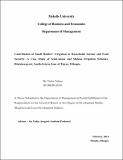| dc.contributor.author | Tedros, Tsehaye | |
| dc.date.accessioned | 2014-11-03T13:47:39Z | |
| dc.date.available | 2014-11-03T13:47:39Z | |
| dc.date.issued | 2014-02 | |
| dc.identifier.citation | Tedros Tsehaye (2014) Contribution of Small Holders’ Irrigation to Households Income and Food Security: A Case Study of Gum-selasa and Shilena Irrigation Schemes, Hintalowejerat, South-Estern Zone of Tigray, Ethiopia, Thesis. Mekelle:MU. | en_GB |
| dc.identifier.uri | https://opendocs.ids.ac.uk/opendocs/handle/20.500.12413/4975 | |
| dc.description.abstract | The objective of this study is to assess the contribution of smallholders‘ irrigation to farm household‘s production and income with special reference to Gum-selasa and Shilena irrigation systems (schemes) in Hintalowejerat Woreda of south-eastern zone of Tigray Region. Both irrigation systems (schemes) are located in the arid and drought-prone areas where crop failure is a recurrent phenomenon due to insufficient and erratic rainfall. The study has focused on examining the income contribution of irrigated agriculture on farm households who are using dam water for irrigation. In order to undertake this research both qualitative and quantitative methods were employed. Qualitative method is used to capture data pertaining local perception and opinions on the contribution of irrigation to household income using focus group discussion and key informant interview. Quantitative data on households‘ resource ownership, income status, food security status, demographic characteristics and other basic data were collected from sample households using semi-structured questionnaire. Sample household heads were selected from the prepared list of irrigator household heads in both study areas through the lottery method. Findings of this study show that smallholder irrigations is very important especially in those areas where insufficient and erratic rainfall is a recurrent phenomenon as a result rain fed agricultural production is not a dependable enterprise. For instance, of the available income sources, the average household income obtained from irrigation cultivation constituted 71.5%, 74.4% and 76 % during the three years period (2011-2013) in Gum-selasa. In Shilena, the average household income obtained from irrigation cultivation was 70.2% 74.73% and 78% as compared to other sources of income respectively (2011-2013). The study also revealed that the major challenges that inhibit the optimal utilization of the irrigation schemes or problems affecting irrigation performance (income) are lack of storage facilities, lack of market information and low price for cash crop produce during the harvesting period.
Based on the results of the study the researcher recommended the following: these are, improving the marketing system, ensure fair price for agricultural inputs and Provision of storage facilities in order to empower the irrigator farm households in price decision. | en_GB |
| dc.language.iso | en | en_GB |
| dc.rights.uri | http://creativecommons.org/licenses/by-nc-nd/3.0/ | en_GB |
| dc.subject | Economic Development | en_GB |
| dc.subject | Rural Development | en_GB |
| dc.title | Contribution of Small Holders’ Irrigation to Households Income and Food Security: A Case Study of Gum-selasa and Shilena Irrigation Schemes, Hintalowejerat, South-Estern Zone of Tigray, Ethiopia | en_GB |
| dc.type | Thesis | en_GB |
| dc.rights.holder | Mekelle University | en_GB |


